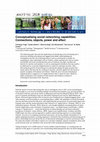Papers by Christian Voigt
Moore, A., Pammer, V., Pannese, L., Prilla, M., Rajagopal, K., Reinhardt, W., Ullman, Th. D., & V... more Moore, A., Pammer, V., Pannese, L., Prilla, M., Rajagopal, K., Reinhardt, W., Ullman, Th. D., & Voigt, Ch. (Eds.) (2012). Proceedings of the 2nd Workshop on Awareness and Reflection in Technology Enhanced Learning. In conjunction with the 7th European Conference on Technology Enhanced Learning: 21st Century Learning for 21st Century Skills (ARTEL/EC-TEL 2012). September, 18, 2012, Saarbrücken, Germany. Available online at http://ceur-ws.org/Vol-931/. ... Items in DSpace are protected by copyright, with all rights reserved, unless otherwise indicated.
The rapid growth of online learning environments in educational institutions of all sorts is lead... more The rapid growth of online learning environments in educational institutions of all sorts is leading to a search for effective methods of teaching in an online environment. Existing techniques, while adequate for most purposes, have some real limitations - one of which is the provision of effective learning while ensuring successful interaction among groups of people who may never see either the instructor or one another. In this paper the authors discuss the use of electronic case-based learning (e-CBL) as a means of providing an effective learning context, focusing particularly on the ways in which effective interaction can be optimised. The paper presents a review of the literature on case-based learning and then discusses the results of a first iteration within a design-based research project.

An increasingly aging population as well as a change in awareness of the needs of people with mob... more An increasingly aging population as well as a change in awareness of the needs of people with mobility impairments raises the importance of having meaningful information on accessibility to guide further action. This challenge is likely to increase, as 24% of the whole population in Vienna will be aged 65 plus by 2030 (Statistics Austria, 2014).
In an effort to map the accessibility of restaurants, leisure facilities or libraries, internet-based, mobile applications - such as Wheelmap.org - are used to crowdsource information about accessible places and to raise awareness about accessibility by engaging citizens in the data collection process. Wheelmap (founded in 2010 by the German non-profit organisation 'Sozialhelden') is an online application to find and map wheelchair accessible places based on a traffic light system: red (non-wheelchair accessible), yellow (partly wheelchair accessible), green (wheelchair accessible). Additionally, an online platform ‘berollbar.at’, is currently under development, striving to encourage citizens to test mapping technologies and comment on accessible routes and pathways in Vienna.

Cities are complex systems. Different stakeholders with diverse interests and intentions come fro... more Cities are complex systems. Different stakeholders with diverse interests and intentions come from public administration, industry sectors, research, real estate, service providers, civil society organisations, etc. In order to make sound decisions for a city, decision makers need to cross thematic as well as administrative borders. Novel ways of decision making include increasing inter-organisational cooperation on the one side and more interactive formats of citizen participation on the other side. Whereas 'big data' has enormous potential to support these developments from an information systems' perspective, they also raise concerns about the possibility of misleading data interpretations or unnecessary privacy violations. This paper presents conceptual design recommendations including principles of value sensitive data selection and the contextual integrity of data interpretation.
The influential role of contextual factors in determining success or failure of e-learning initia... more The influential role of contextual factors in determining success or failure of e-learning initiatives is widely acknowledged, yet systematic approaches to catpture, analyse and possibly instrumentalise these factors are still rare. This paper presents a three stages roadmapping process including : (1) the appreciation of existing needs, visions and challenges, (2) the alignment of locally perceived drivers and globally unfolding trends and (3)the anticipation of potential game changers. Each stage is illustrated with data from the corporate sector, discussing the conditions under which microlearning has to assert itself in the future.
Motivational and Affective Aspects of Technology …
19th Australasian Conference on Information …, Jan 1, 2008
This paper evolves around the challenge of ensuring sufficiently guided learning on one side and ... more This paper evolves around the challenge of ensuring sufficiently guided learning on one side and self-directed, learner-centred learning on the other side. An online course using collaborative case-based learning is taken as an example to discuss tradeoffs between designing collaborative processes upfront and the need to allow for emergent, unspecified forms of collaboration. To do so, collaborative learning is conceptualised as being influenced by three different kinds of logic: formal, informal and practical. Examples for scripted, polychronic and improvised interactions are to illustrate the interplay between the three kinds of logic.
Telmap - Surveying innovative learning practices, Mar 2013
The report is structured as follows:
- A brief methodology section is dedicated to the purpose o... more The report is structured as follows:
- A brief methodology section is dedicated to the purpose of practice- and policy foresight, the means we used to promote the survey and some details on the programming of the survey using the open source software Limesurvey.
- The next section describes the participants of the survey in terms of their demographic data and their response behaviours.
- We then go through each innovative learning practices highlighting some general developments as well as some weak signals, which we derived from differing, group- specific responses or whenever a development was seen very far in the future.
unisanet.unisa.edu.au
This paper gives a critical account of how a strategy group selected a university-wide ePortfolio... more This paper gives a critical account of how a strategy group selected a university-wide ePortfolio solution. While the strategy group's cross-disciplinary and cross-departmental nature ensured a comprehensive perspective on the issues, the diverse expertise of all participants did also pose the challenge of integrating the different knowledge domains and keeping the discussion streamlined. The recommendation of a particular ePortfolio application was achieved only after the medium was framed and reframed in terms of it being (1) a strategic innovation, (2) an enabler of various pedagogies, and (3) a 'software package'. We suggest that prototypes, frames and metaphors are valuable means to structure discussions around ePortfolios and preserve coherence in an otherwise complex debate.

Improving Quality of Vocational Training – Tools, Frameworks and Current Practices, EFQUEL, Nov 2013
ELIA stands for Emotional Literacy (EL) in Action and is a Transfer of Innovation project within ... more ELIA stands for Emotional Literacy (EL) in Action and is a Transfer of Innovation project within the EU Lifelong Learning Programme. ELIA’s objective is to support vocational education and training (VET) teachers to improve communication and interaction with young people, in order to increase their motivation, engage them in learning, and raise achievement. Our emotions play an important role in our ability to communicate with and comprehend others. Emotional literacy approaches can contribute to the creation of a climate for engagement and learning in the VET classroom, recognising the emotional state of the VET students and the teacher and ensuring that emotions are harnessed for learning rather than obstructing it. ELIA focuses on a neglected aspect of emotional literacy in an education context, teachers’ own emotional literacy.
Technology Enhanced Learning is facing the challenge of ever-faster changes producing new technol... more Technology Enhanced Learning is facing the challenge of ever-faster changes producing new technologies as well as altering expectations about what education should look like in the future. Hence, stakeholder groups such as policy makers, technology providers as well as end users need to keep track of emerging signs of change -weak signals. However, it is not trivial to recognise such weak signals. We start with elaborating potential reasons for missing early warning signs such as 'filtered communications' and 'untapped creativity'. We then suggest an operational framework aiming to minimize filtering and maximising creative expression to elicit a maximum of weak signals. Eventually we present results from first interviews, taking new learning paradigms and the future cost of TEL as an example.
ascilite.org.au
Existing implementation guidelines for ePortfolios frequently assert that a thorough longterm str... more Existing implementation guidelines for ePortfolios frequently assert that a thorough longterm strategy is needed. However, the implications of such a demand are not entirely clear. Research on ePortfolios is primarily focused on promoting learning, accreditation or career development of individuals. This paper makes a point for broadening the scope of analysis and design, considering the roles of potential audiences of ePortfolios early on. It is suggested that looking at ePortfolios as community-driven practices provides a fresh approach to student buy-in and motivation. The argument is conceptual in nature, linking the literature on ePortfolio uptake with research on communities. A set of recommendations and caveats about how to get community-embedded ePortfolios started stands as conclusion.
In P. Goodyear & S. Retalis (Eds.), Technology-enhanced learning: Design Patterns and Pattern Languages: Sense Publishers, Rotterdam.
There is widespread discussion of the suitability of design patterns for disseminating praxis-rel... more There is widespread discussion of the suitability of design patterns for disseminating praxis-relevant design knowledge. Much of their appeal arises from the disappointing take up of design recommendations. The current interest in design patterns can be seen as a reaction against an increasing number of models that only partially fit the needs of educators and designers (Coplien 2004; Niegemann, Hessel & Domagk 2004). Where an abundance of paradigmatic and theoretical perspectives can be confusing, patterns aim to reduce the abstractness of theories, and support practitioners, by explicitly referencing the context under which an educational design works.
Proc. 23rd ASCILITE Conference, Sydney, …, Jan 1, 2006
In this paper we analyse the use of patterns across a number of fields including architecture, so... more In this paper we analyse the use of patterns across a number of fields including architecture, software development and educational technology design. Focusing on the reusability of a pattern outside its area of development, we have identified several issues related to the context and the value system of a pattern. The paper draws together lessons learned from different fields where patterns are already used and described. We conclude with a recommendation of pattern descriptors and guidelines which improve their applicability in varying value systems.
i-Know Conference 2012, Practice Presentation, Oct 2012
Research 2.0 is largely understood as the use of Web 2.0 technologies for research related activi... more Research 2.0 is largely understood as the use of Web 2.0 technologies for research related activities such as engaging with communities or exploring community generated data. The latter is the focus of this paper, which investigates the potential of text mining blog posts in order to inform roadmapping processes. Subject to the further refinement of algorithms we can see text mining becoming a valuable source to inform decision makers about the wider context of their roadmapping activities in efficient ways. A step towards realizing text mining’s full potential is a conscious exploration of what it can or cannot achieve yet.

cms.ascilite.org.au
The following paper discusses the implications of introducing social networking into a university... more The following paper discusses the implications of introducing social networking into a university teaching environment and suggests that further understanding and investigation into the role technology plays in such an environment is needed. In examining in-class technologies such as Clickers, online teaching tools such as Centra and Moodle and social networking sites such as Facebook, the paper considers the benefits for teachers and students, as well as examining the drawbacks that may need to be addressed for successful implementation in relation to learning outcomes. After discussing the growth of networking in an educational setting, the paper presents four major aspects that describe the working of networks, and then applies this discussion to specific examples of Facebook and Clickers. While the move towards technological implementation is supported, it is emphasised here that it cannot be done without indepth examination of the position of both teachers and students in relation to technological innovation in the classroom.

Different forms of blended and fully online learning play an ever more important role in today's ... more Different forms of blended and fully online learning play an ever more important role in today's higher education. Consequently, universities ramp up their provisions of educational technologies in order to increase students' flexibility and create more engaging learning environments. Given that implementing new technologies requires substantial investments in terms of adopters' and implementers' time, it is only natural to hear questions about the benefits that could be expected and whether these benefits would scale across the university. The paper applies an ‗adoption of innovation' point of view and argues for the importance of continuously monitoring and improving two characteristics of a learning management system: usability and innovativeness. The paper includes a set of lessons learned and finishes by summarising the support required to sustain or speed up rates of adoption in pedagogically meaningful ways.

In this paper we present a perspective of case discussions in an online learning environment base... more In this paper we present a perspective of case discussions in an online learning environment based on Activity Theory, which allows us to analyse the embedded nature of students' learning activities. We see Activity Theory as a first step towards structuring the complexity of students' experiences in today's higher education systems, recognising the distinction between potential and actual learning activities. Preliminary results of a study of an undergraduate course which used several forms of synchronous and asynchronous communication demonstrate the effect of taking an activity theory perspective of instructional design decisions. Although online case discussions can be supported through scripts and scaffolds to overcome the logistical and epistemological problems of online collaboration, the use of synchronous communication technology revealed that constraints such as low bandwidth and a complex software interface still present major hurdles to the smooth integration of synchronous technologies.











Uploads
Papers by Christian Voigt
In an effort to map the accessibility of restaurants, leisure facilities or libraries, internet-based, mobile applications - such as Wheelmap.org - are used to crowdsource information about accessible places and to raise awareness about accessibility by engaging citizens in the data collection process. Wheelmap (founded in 2010 by the German non-profit organisation 'Sozialhelden') is an online application to find and map wheelchair accessible places based on a traffic light system: red (non-wheelchair accessible), yellow (partly wheelchair accessible), green (wheelchair accessible). Additionally, an online platform ‘berollbar.at’, is currently under development, striving to encourage citizens to test mapping technologies and comment on accessible routes and pathways in Vienna.
- A brief methodology section is dedicated to the purpose of practice- and policy foresight, the means we used to promote the survey and some details on the programming of the survey using the open source software Limesurvey.
- The next section describes the participants of the survey in terms of their demographic data and their response behaviours.
- We then go through each innovative learning practices highlighting some general developments as well as some weak signals, which we derived from differing, group- specific responses or whenever a development was seen very far in the future.
In an effort to map the accessibility of restaurants, leisure facilities or libraries, internet-based, mobile applications - such as Wheelmap.org - are used to crowdsource information about accessible places and to raise awareness about accessibility by engaging citizens in the data collection process. Wheelmap (founded in 2010 by the German non-profit organisation 'Sozialhelden') is an online application to find and map wheelchair accessible places based on a traffic light system: red (non-wheelchair accessible), yellow (partly wheelchair accessible), green (wheelchair accessible). Additionally, an online platform ‘berollbar.at’, is currently under development, striving to encourage citizens to test mapping technologies and comment on accessible routes and pathways in Vienna.
- A brief methodology section is dedicated to the purpose of practice- and policy foresight, the means we used to promote the survey and some details on the programming of the survey using the open source software Limesurvey.
- The next section describes the participants of the survey in terms of their demographic data and their response behaviours.
- We then go through each innovative learning practices highlighting some general developments as well as some weak signals, which we derived from differing, group- specific responses or whenever a development was seen very far in the future.